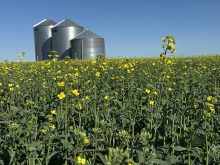BSE shakes fed market
News of a third Canadian BSE positive cow last week threw the fed market into uncertainty, said Canfax.
In the end, steer averages fell $1.50 per hundredweight and fed heifers were 25 cents stronger, said Canfax.
The frigid weather also affected the market, but surprisingly volume for the week was 24,385 head, up 35 percent from the week before. Most of the activity occurred midweek.
Alberta prices Jan. 13 were steers $85 per cwt., flat rail $140-$141.85 and heifers $84.50, flat rail $141, Canfax said.
Read Also

Huge Black Sea flax crop to provide stiff competition
Russia and Kazakhstan harvested huge flax crops and will be providing stiff competition in China and the EU.
The wholesale beef market improved in Canada and rose strongly in the United States after Tyson and National Meats temporarily closed some of their plants.
Canadian cutouts (AAA and AA) two weeks ago were $5.50-$5.75 per cwt. higher than the previous week, but $3.75-$7.75 lower than a year ago.
The better beef price should encourage Canadian packers back to five-day-a-week operation, said Canfax.
In the U.S., Choice product was nearly $14 US higher, while Select was almost $14.50 higher. That was a 10-11 percent increase over the week before and an 11-12 percent increase over last year.
The stronger meat market, combined with cold weather and the fact that most feedlots do not have a lot of overweight cattle, mean the fed cattle market should see prices in the mid $80s this week, Canfax said.
Feeder deliveries up
Despite the cold and the worries over BSE, Alberta auction markets saw more than 10,000 head trade, more than four times as many cattle as the week before and an increase of 40 percent over last year, said Canfax.
Prices were steady to stronger.
Steers 500-700 pounds were $3.50-$5 Cdn higher and 700-900 lb. and heavier steers rose $2.25-$3.
Heifers 400-600 lb. were steady to $1 higher, while 600-900 lb. traded $1-$1.50 stronger.
Heifers 900 lb. and heavier rose $4.25.
D1, 2 cows were 50 cents higher and butcher bulls held steady.
While some feeder cattle trade dipped with the BSE announcement, most markets had recovered by late in the week, Canfax said.
Buyer interest is expected to remain strong and warmer weather might encourage more movement.
Stock bred cows in limited trade in central Alberta were $425-$535, while bred heifers were $650-$780.
American hogs fall
While Canadian live hog prices rose last week, reflecting the one-week lag from the U.S. market, American prices decreased until midweek but then jumped back to slightly better than the value at the start.
The average Iowa-Minnesota daily direct hog price (51-52 percent lean carcass converted to live weight) was $55.29 US per cwt. on Jan. 13. That was about one percent lower than the week before.
The wholesale cut-out price was about steady.
Weanling pig prices continue to break records in Manitoba. For the week ending Jan. 7, five kilogram pig spot price bids climbed to highs of $75.88 Cdn per pig while contract prices reached highs of $49.84 per pig. Spot prices for 23 kg pigs were to a high of $107.36 and top contracts were at $80.43. The U.S. national direct delivered price for five kg pigs (converted to Canadian dollars) ranged from $39.16-$78.94 per pig and the 23 kg pigs were $83.22-$101.58.
Lambs steady to stronger
Ontario Stockyards Inc. reported 2,855 sheep and lambs and 293 goats traded. Light lambs sold steady, while heavy lambs, sheep and goats traded stronger.
















